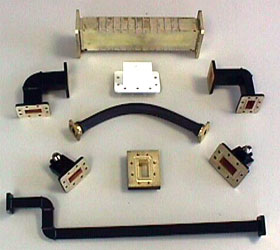Waveguides

A waveguide is any structure that causes waves to follow a certain path instead of spreading out into a larger and larger volume of space. The stethoscope that a doctor uses to listen to sounds in your chest is a waveguide for sound waves. The weak sound waves that come from the body are guided through tubes to the doctor’s ears. Instead of spreading throughout the room, the sound’s energy is restrained to follow a particular path from your chest to the doctor’s ears. This principle of directing the energy of a wave in a particular path is common to all waveguides.
Fiber-optic cables consist of bundles of very thin fibers made of a special kind of glass that is incredibly transparent to infrared light. (Infrared light is like visible light, only its wavelength is slightly too long to be seen by the human eye. Heat rays are infrared light.) To send a message through an optical fiber, a laser at the transmitting end shines infrared light that is “modulated” (made to carry information) into the optical fiber. The fiber is so transparent that the light can travel tens or hundreds of miles before it must be strengthened (“amplified”) to continue on its way. If you tried to shine the laser’s beam into the air, it would spread out and be scattered away after only a few feet. It is the guiding property of the optical fiber, along with its very good transparency, that allows the light beam to travel as far as it does. At the receiving end, the light beam is turned into an electrical signal that conveys voice, video, or computer data information.
Waveguides are also useful for carrying microwave radio signals. The first type of waveguide used with microwaves was a hollow metal pipe. The microwaves can be considered to bounce back and forth between the walls of the pipe as they travel down the guide. However, with this type of waveguide, the wavelength of the microwave cannot be too long, or else the wave cannot go very far. This means that the longer-wavelength microwaves need bigger pipes, which get too large to be practical for long microwaves.
Other types of waveguides used for microwaves include coaxial cables (basically the same kind of cable used in cable TV systems) and a kind of printed-circuit structure called “microstrip.” Microwaves can travel for short distances on a printed-circuit board similar to the ones used inside computers. The problem with a microstrip is that it consumes too much energy from the microwave to be useful for distances of more than a few feet. On the other hand, the hollow-tube type of waveguide can be used for distances of several hundred feet or more.
Waveguides are also used in microwave ovens where they convey the microwave power from the microwave generator (an electron tube called a cavity magnetron) to the inside of the oven where the food is. A waveguide is used because it absorbs very little of the power generated by the magnetron, leaving most of the power available to heat the food.
Further Reading
In 1897, Lord Rayleigh conceives the use of waveguide, but that idea was never taken up. It was to be rediscovered in the 1930’s. See a key article below: MTT Waveguide History
In 1910, Jagadish Chandra Bose experimented with radio at around 60GHz using optical style components, many of which can now be recognised as waveguide.
